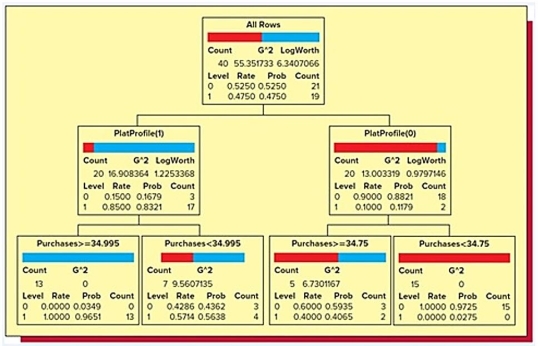Multiple Choice
Suppose that a bank wishes to predict whether or not an existing holder of its Silver credit card will upgrade, for an annual fee, to its Platinum credit card. To do this, the bank carries out a pilot study that randomly selects 40 of its existing Silver card holders and offers each Silver card holder an upgrade to its Platinum card. Here, the response variable Upgrade equals 1 if the Silver card holder decided to upgrade and 0 otherwise. Moreover, the predictor variable Purchases is last year's purchases (in thousands of dollars) by the Silver card holder, and the predictor variable PlatProfile equals 1 if the Silver card holder conforms to the bank's Platinum profile and 0 otherwise. Below is the classification tree they derived from the data collected in the study.  Based on this classification tree, which of the following Silver card holders would the bank classify as a non-upgrader (assuming they classify those with an upgrade probability estimate of at least .5 as upgraders) ?
Based on this classification tree, which of the following Silver card holders would the bank classify as a non-upgrader (assuming they classify those with an upgrade probability estimate of at least .5 as upgraders) ?
A) PlatProfile(1) & Purchases = 31.50
B) PlatProfile(1) & Purchases = 39.55
C) Purchases = 18.25
D) Purchases = 34.99
E) PlatProfile(0) & Purchases = 49.80
Correct Answer:

Verified
Correct Answer:
Verified
Q90: An MBA admissions officer wishes to predict
Q91: The optimal value of k to use
Q92: An internet service provider (ISP) has randomly
Q93: An automobile finance company analyzed a sample
Q94: Which of the following would you find
Q96: An MBA admissions officer wishes to predict
Q97: An automobile finance company analyzed a sample
Q98: The k-nearest neighbors approach can be used
Q99: An internet service provider (ISP) has randomly
Q100: One approach to avoid overfitting a classification